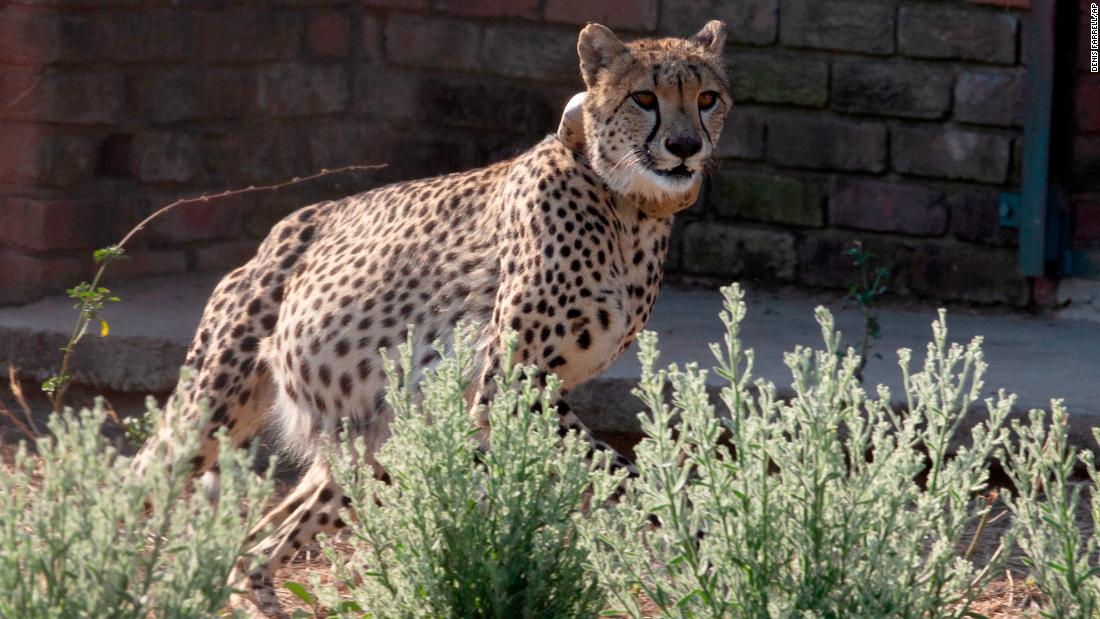
Cheetahs were declared extinct in India in 1952 and are the only large carnivore in the country to have suffered that fate.
But the endangered cats used to have a much larger range. Historically, cheetahs roamed throughout the Middle East and central India as well as most of sub-Saharan Africa. Habitat loss, poaching, and conflict with humans have greatly reduced their populations.
The animals chosen for the 11-hour trek were selected “based on an assessment of health, wild disposition, hunting skills, and ability to contribute genetics that will result in a strong founder population,” says the organization.
It took a multi-step journey to get the cats from Namibia, on Africa’s southwestern coast, to central India. On Friday, the cheetahs traveled from the CCF’s center to the Hosea Kutako International Airport in Windhoek, Namibia. Then, they took a private jet to Jaipur, India. Finally, on Saturday the cats were taken to Kuno National Park and released into their new home.
“As a conservationist, I am thrilled, and as CCF’s leader, I am exceptionally proud of the work of our CCF reintroduction team,” Laurie Marker, the founder and executive director of the CCF, said in the release. “Without research and dedication to cheetah conservation, this project could not take place.”
Jhala Yadvendradev, dean of the Wildlife Institute of India and principal scientist for India’s Project Cheetah, said that the project will benefit India’s ecoystems at large — not just cheetahs.
“Bringing back a top predator restores historic evolutionary balance, resulting in cascading effects, leading to better management and restoration of wildlife habitat, for the benefit of all species, and will uplift the livelihoods of poor forest dwelling communities,” Yadvendradev said in the release.
A previous attempt to bring African cheetahs to Kuno National Park in 2012 was halted by India’s Supreme Court, which suggested that introducing a non-native species was problematic and warned the there might not be enough prey in the park to keep them fed.
SP Yadav, Director General of Project Cheetah, said India has worked to prepare the park over several years, through anti-poaching measures and boosting the amount of prey.
However, Faiyaz Khudsar, a conservation biologist who worked at the Kuno National Park for around eight years, is concerned the cheetahs may still not have enough to eat.
“If naturally you build up the population of the prey base and then you bring in a new species or predator, it’s sustainable. (But if you bring in a) prey base from somewhere else … I don’t know which direction it will go after six months or a year,” Khudsar told CNN.
Khudsar also said the cheetahs would have competition from aggressive other predators like leopards.
But Adrien Tordiff, associate professor at the University of Pretoria, who has been involved with Project Cheetah since 2020, said the cheetahs from South Africa had been selected with the National Park’s other creatures in mind.
“Because they’re going into areas where there’s quite a high leopard density, we wanted animals that are really quite wild and very used to being with other large carnivores, lions, leopards and so on. So they’re not naïve of those carnivores, and they can avoid them, they can defend themselves against them, they’re really aware of what they are and the risks that they pose to them,” Tordiff told CNN.
India’s Ministry of Environment, Forest and Climate Change believes that bringing cheetahs back to India “will likely result in better conservation of open forest, grassland, and scrub ecosystems for which they will serve as a flagship species.”
The Indian government believes the factors that led to the cheetah’s extinction within the country — primarily hunting and habitat loss — have “abated.”
Under the British Raj, forests were cleared to develop settlements and set up plantations, resulting in the loss of habitat for big cats, such as the cheetah. Considered less dangerous than tigers and relatively easy to tame, cheetahs were also frequently used by Indian nobility for sport-hunting.
According to Jhala, the last cheetahs were shot in 1947, shortly before they were officially declared extinct.
